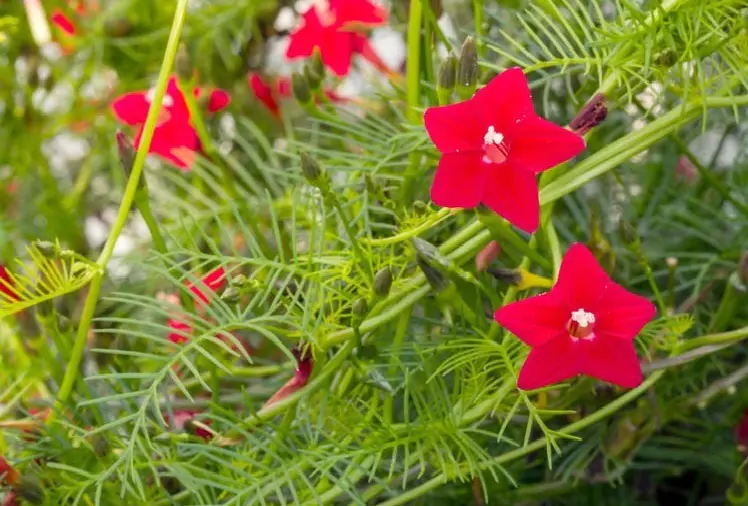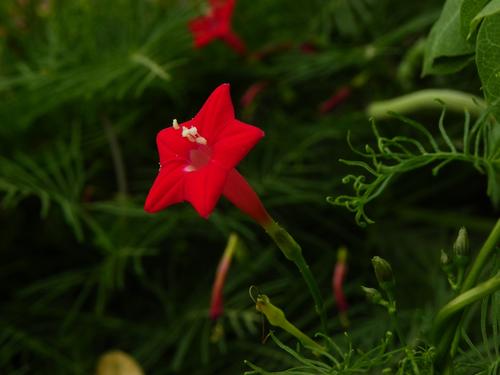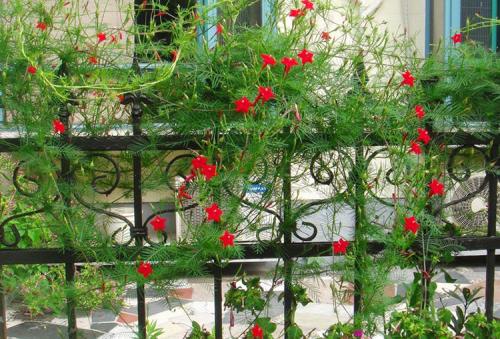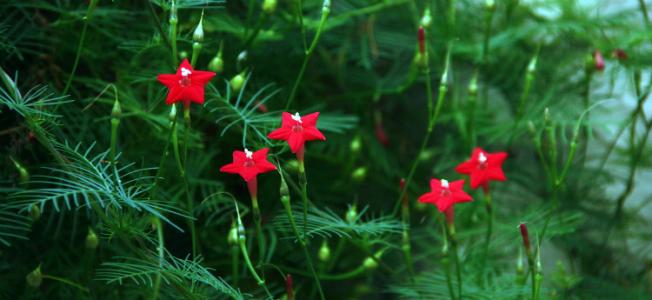Cypress Vine (Ipomoea Quamoclit) Profile: Info, Care & Growing Guide
Written by Lisa
Nov 12 2021

Cypress Vine (Ipomoea Quamoclit), native to Mexico, has a long flowering period and does not require much fertilizer. It can germinate when seeded on wet soil, with a germination rate of more than 95%.
Cypress Vine Picture

Cypress Vine Quick Info
| Botanical/Scientific Name | Ipomoea Quamoclit |
| Common Name | Cypress Vine |
| When to Grow/Bloom/Harvest | Bloom from June to October |
| Uses | Treat sore throat, cracks, throat pain, vocal disorders |
| Origin | Central America, the northern tropics of South America, and Mexico |
| Light Care | Full sun |
| Soil Care | Well-drained |
| Temperature Care | Above 50 degrees Fahrenheit both day and night |
| Humidity Care | Moist |
| Watering | Water the vine when you see it wilting |
| Pruning Care | Light pruning for this plant |
| Fertilizer Care | Fertilize just before the first blossoms appear with a high phosphorus fertilizer |
| Propagation | Seeds |
| Toxic | Low severity poison characteristics |
| Flower Color | Red, pink or white |
When to Plant Cypress Vine
Cypress vine is usually planted in spring, usually in early April. The warm climate is very helpful for the growth of cypress vine. If it is planted in high temperature season, it is easy to affect the growth of seedlings due to high temperature and strong light. When sowing in winter, the cold climate will inhibit the rooting of the seed, resulting in its inability to germinate.When does Cypress Vine Bloom & Harvest
The flowering period of cypress vine is from early July to late September. It will open every day during flowering, open in the morning and wither in the afternoon. Its fruit maturity is from September to November. Cypress vine inflorescences axillary, flowers solitary or clustered. Cypress vine pedicels are very long, mostly longer than leaves, up to 10 cm.Cypress Vine Characteristics
An annual tender, twining herb, glabrous. The leaves are ovate or oblong, 2-10 cm long, 1-6 cm wide, single leaves alternate, the lobes of the leaves are slender and silky, pinnately deeply divided to midrib, with 10-18 pairs of linear to filamentous flattened The fine lobes of the lobes, the apex of the lobes are sharp; the petiole is 8-40 mm long, and the base often has false stipules. Inflorescences are axillary, composed of a few flowers to form cymes. (Find more Climbing Plants with Flowers here.)
The total pedicel of Cypress Vine mostly exceeds the leaf, 1.5-10 cm long, the flower is upright, the stalk is longer than the calyx, 9-20 mm long, and thickens into a rod when it is fruit; the sepal is green, slightly unequal in length, elliptical to oblong Spoon-shaped, the outer one is slightly shorter, about 5 mm long, with a blunt tip and a small convex point; the corolla is tall and dish-shaped, about 2.5 cm long, dark red, glabrous, weak tube, slightly enlarged upper part, crown eaves open , About 1.7-2 cm in diameter, 5-lobed; stamens and styles protruding; filament base hairy; ovary glabrous. There are a few small five-pointed star-shaped flowers, bright red in color, and white in addition to red. Cypress Vine's slender and smooth trailing stems can grow up to 4-5 meters. They are soft and very climbing, making them ideal hedge plants.
Cypress Vine Habit
Cypress Vine likes light and warm and humid environment. It grows in areas from 0 to 2,500 meters above sea level. It is not cold tolerant and can be self-sown (generally introduced and cultivated by hand) and requires fertile soil. Cypress Vine has strong resilience and easy management. Cypress Vine fruit contains 4 seeds, which fall to the ground after maturity, and regenerate in the following year. If Cypress Vine is planted manually, plant it in March. The seedlings are 10 cm long for transplantation. In order to make Cypress Vine bloom more, it should be planted in fertile soil in the sun. Potted plants must stand on a stand for entanglement, and they are extremely delicate and beautiful when they bloom.

Cypress Vine Distribution
Cypress Vine is native to tropical America and is now widely distributed in temperate and tropical regions around the world. It is a beautiful garden ornamental plant.
Cypress Vine Care in Detail
Because Cypress Vine is native to tropical regions, it likes warmth, avoids cold, and is afraid of frost. When the temperature is low, it grows very slowly. The suitable temperature for seed germination is 20-25℃. A sunny environment is required, and most types do not require strict sunshine hours. Cypress Vine fruits are inconsistent in maturity, and they are easy to fall off after maturity, so they should be picked as they mature. Each fruit contains 3-4 seeds. If there are both red flower and white flower plants, they should be collected separately.Cypress Vine Watering
Cypress vine originates near the equator, that is, the tropical zone with high temperature and rainy. Therefore, we can know that its demand for water is still relatively large. Cypress vine can't stand too dry environment, which has high requirements for our watering.
In late spring or early summer, this is a good time to plant cypress vine. After planting, the demand for water is relatively large. We must keep the soil moist. In fact, it goes without saying that we also know that the growth and development is fast at this time, and water is naturally indispensable.
However, in late autumn and even winter, the growth of cypress vine is almost stagnant and even enters the dormant stage. Of course, the demand for water is relatively small. It can be watered without watering, or once every half a month. If the soil is too dry and cracked, you can properly pour some more water to make the basin soil slightly wet.
Cypress Vine Soil
Cypress vine is not strict with the soil, but it is better to be loose and fertile. You can choose the fertile soil in the sunny place.
Cypress Vine Light
Cypress vine likes light very much and maintains good light conditions during daily maintenance. It can be grown in ordinary soil, but it is best to provide soft soil.
Cypress Vine Temperature
Cypress vine is native to tropical areas. It likes warmth, avoids cold and is afraid of frost. It grows very slowly at low temperature. The suitable temperature for seed germination is 20 ~ 25 ℃. Cypress vine requires a sunny environment, and most species do not have strict requirements on sunshine hours.
The most suitable temperature for the growth of cypress vine is about 20-35 ℃, which can withstand a certain high temperature.
Cypress Vine Humidity
As long as the humidity is controlled within a relatively appropriate range, we will find that it takes only one week to plant cypress vine, but the whole seedling propagation cycle of cypress vine can be completed after 45 days. We should pay attention to the nutrient demand of cypress vine, otherwise cypress vine will grow too vigorously and its branches and leaves will be entangled continuously.
Cypress Vine Fertilizer
Cypress vine has no high requirements for fertilizer or even soil. However, although it is not high, there are still certain requirements after all, and fertilization in the correct way also has an important impact on its growth at each stage.
We all know that N, P and K are indispensable to plants as water is to people, so we should choose fertilizers containing sufficient amounts of these three elements. Don't just apply fertilizer containing N, otherwise it will cause the crazy growth of plant branches and leaves, but the number of flowers is small.
Cypress vine itself does not need too much fertilizer, so no matter what time period, even when it grows fastest, excessive fertilization should be avoided. Generally speaking, once every half a month is more frequent.
Cypress Vine Pruning
Cypress vine does not grow in winter and has entered the semi dormant period. This is the most appropriate time to prune cypress vine. After a cycle of growth, cypress vine's branches and leaves are relatively lush. At this time, slender branches can be selected to complete cutting. I believe that cypress vine will become a good cypress vine after cultivation.
Cypress Vine Repotting
Cypress vine grows very fast and can grow to a high height in a year. Therefore, when repotting Cypress Vine seedlings, we need to carry out cypress vine repotting. If we choose fewer flowerpots at the beginning, we need to turn the pots. When turning the pot, abandon the original soil, gently pat the flowerpot with your hand to let the plants fall off automatically, and then beat off the excess soil. The soil we need to prepare during cypress vine repotting is the same as that for transplanting seedlings, but the base fertilizer should be thicker at this time.
Cypress Vine Propagation
Cypress Vine can be propagated with seeds. Sowing in early April. After sowing, pay attention to shade and keep the seedbed moist. Seedlings will emerge after about a week.
Cypress Vine propagation is relatively simple:
① Plant Cypress Vine in the open field. Choose a place with a sunny leeward and good drainage. In addition to applying base fertilizer, topdressing liquid fertilizer should be applied 1-2 times before flowering. When planting, be sure to water thoroughly, and only need to water once a week. (Note that Cypress Vine should not be transplanted after it has grown into a large seedling.
② Potted Cypress Vine. Water at the right time, but not water. It is suitable to broadcast live from late March to late April, sow 5 to 7 seeds in a medium pot, cover 0.5 cm of soil, keep the pot soil moist, emerge in about 10 days, thinning out after half a month, leaving weak and strong, keep 3 to 4 . If a seedling bed is used, it should be sown sparsely. When the seedlings have 3 or 4 leaves, take the seedlings with a small shovel and do not damage the roots, and plant them in a pot. When cypress vine seedlings are 8-10 cm high, they can be pinched to promote multiple branches and flowers. After planting, water once permeable. Later, as the plants grow up and the temperature rises, water once every five to three or two days, and gradually change to once a day. In short, the potting soil should always be kept moist and not waterlogged. Nitrogen, phosphorus and potassium compound fertilizer or granular fertilizer is better for fertilization, avoid single application of nitrogen fertilizer to prevent excessive growth of flowers. When planting Cypress Vine, apply base fertilizer once in January, and apply it once every 15-20 days if there is no base fertilizer.
③Sparse vines and leaves appropriately. It not only facilitates ventilation and light transmission, but also makes the plant shape beautiful. After the flowers die, the remaining flowers should be picked in time to prevent them from setting seeds, so that nutrients can be concentrated for the new branches to bloom, and the flowering period of Cypress Vine can be prolonged.
Cypress Vine has strong self-sown ability. If you don't care about the time of flowering, self-sown seedlings can also be used in the second year of cultivation. However, since there is no seed selection and late emergence, the greening effect is poor. Cypress Vine has a large amount of growth, so you should apply foot fertilizer, spread evenly, and turn deeply. Plan the hole for planting, remove the plastic seedling bowl, plant the seedlings in the hole, 1 plant per hole, cover the seedling lumps with fine soil, and then water and cover the hole with soil. Single-row planting should have a plant spacing of about 35 cm, and the plant spacing for seedling cultivation or fertile soil should be larger; self-sown seedlings should emerge late and grow later, and the plant spacing should be smaller. Watering in time can promote the growth of stems and leaves, but be careful not to grow wildly so as not to delay flowering. In the early stage, artificial assisted vines were introduced to scaffolds, fences, trees or other supports. In the middle and late stages, the plant itself has a strong climbing ability, so you don't need to worry about it except for styling. Potted plants should be watered and fertilized frequently.
Cypress vine propagation with seeds. Seeds can be harvested in early November each year and sown in April the following spring. They can germinate a week later. The seedlings will be planted when they have 3-4 leaves. When the seedlings are too large, transplantation will not be easy to survive. When Cypress Vine matures, the seeds will split naturally and reproduce by themselves. Cypress Vine has strong vitality, good adaptability, and generally has no pests.
Cypress Vine Seeding
Seedlings are grown in protected areas in spring. After the final frost, the number of days for growing seedlings in the open field is about 45 days, not too long, otherwise the vines from the seedlings will be entangled.
Use ordinary Cypress Vine seedlings with nutrient soil to sow and cultivate seedlings to grow well. Use seedling trays for sowing. The seedling amount per square meter is about 100 grams, and the fine soil is about 1.5 cm after sowing. It should not be too thin, otherwise it will be easy to unearth with the seed coat. Control the ground temperature at 20-25℃, sowing dry seeds for 4 days to emerge. Cypress Vine seedlings are easy to emerge, but they are often irregular, so the seedlings should be carefully selected so that the seedlings are neat. Cypress Vine seedlings are very afraid of drought, and will die when the drought is a little bit heavy. It is difficult to recover even if watered. Special attention should be paid to this when raising seedlings. Because it is a taproot plant, it is best to use a plastic seedling bowl with a diameter of 8 cm to grow seedlings, and only transplant the seedlings once, and plant 1 seedling in each container. 72-hole plug trays can also be used to cultivate seedlings, and attention should be paid to water supply during seedling cultivation. The soil moisture is moderately controlled in the middle and late stages of nursery. Seedlings should always be fully exposed to light. If the seedlings are large and the vines are entangled, they should be separated as soon as possible, and the seedling bowl should be moved a certain distance if necessary.
Cypress Vine red flowers are showier than white flowers, and most people prefer red flowers. But even if all the red flower seeds are harvested, most offspring may separate white flowers. The seeds are not easy to distinguish, but the seedling stage is easy to distinguish. The stems of red flowers are dark red, and the stems of white flowers are green, which can be distinguished by careful observation. If you carefully select seeds every year, and pay attention to isolation, the offspring will be less and less mixed.

Cypress Vine Application
Cypress Vine has slender and beautiful leaves. It is an excellent plant for garden flower stands and hedges. It can also be potted indoors. During the blooming season, the flower shape is small, but scattered among the green leaves, it is lively and moving. Cypress Vine can be used as a greening material for fences and scaffolding, and can also be used as a ground cover plant without a support, and it can climb the ground with it. In addition, it can also be used for potted plant viewing, scaffolding, and climbing into various shapes.
Cypress Vine Pest & Disease Control
Leaf Spot
Leaf spot is one of the diseases of cypress vine, which will lead to the decline of plant growth. Pay attention to pruning at ordinary times, and spray tobuzin after the disease. Leaf spot disease is caused by the infection of pineapple with bacteria. The disease is that there are dark brown spots on the leaves, and there will be long strip spots on the stems and petioles. At first, they are relatively small, but they will gradually expand, and finally they will become irregular shapes. The disease spots will also have wheel lines, which will eventually lead to poor growth, wilting and death of pineapple.
[Prevention and Control]: the treatment of leaf spot disease is to spray 800-1000 times of 38% copper oxystrobin, 1000 times of 50% tobuzin, etc., once every 7-10 days, 2-3 times. When we take care of cypress vine at ordinary times, we should pay attention to the air humidity should not be too high. At ordinary times, we should pay attention to appropriate pruning to make the branches and leaves dense and not too concentrated, so that the light transmittance can be guaranteed.
Powdery Mildew
Powdery mildew is relatively easy to identify. It begins to appear small yellow spots on the leaves, and the spots will continue to expand into circles and ellipses. The surface of the spots will produce a white powdery mildew layer. The affected parts are mainly the leaves in the lower half of cypress vine. If powdery mildew is treated in time, it will decline due to the reduction of photosynthesis.
[Prevention and Control]: the treatment of powdery mildew is mainly to spray 1000 times of 15% Triadimefon, and the method to prevent it is relatively simple, because its production is related to fertilization and planting density. Powdery mildew is easy to occur if less fertilization or more nitrogen fertilizer is applied at ordinary times. In addition, too high planting density and opaque branches and leaves are also the main reasons for powdery mildew.
Aphid
Aphids are characterized by sucking the juice of cypress vine, resulting in malnutrition, and then their leaves turn yellow, wither and do not bloom. Although they are small, they reproduce quickly and in large quantities. If they are not controlled in time, they will not only cause a large number of leaves to fall, but also make cypress vine infected with more serious diseases. Therefore, we should not underestimate the harm brought by aphids.
[Prevention and Control]: if we find that a small number of aphids can be scraped by brush or wet cloth, but when a large number of aphids appear, they should be sprayed with drugs. For example, 40% Omethoate emulsion 2000 times liquid can kill the aphids very well. In addition, we should pay attention to environmental sanitation and good ventilation to reduce and prevent the emergence of aphids.
Read Next:
Top 20 Climbing Plants with Flowers for Your Garden
Latest Updated
- Benefits of Bugleweed - 7 Science-backed Health Benefits
- Bugleweed Dangers & Side Effects - Is It Poisonous?
- How to Plant Evergreen Trees - What You Should Know
- When to Plant Evergreens - Grow Guide for Evergreen Trees
- 12 Wonderful Evergreen Shrubs for Your Garden
- 12 Popular Evergreen Plants with Pictures for Beginners
- When And How To Prune A Lilac Bush Like a Pro
- How to Grow & Care for Lilac Vine (Hardenbergia Violacea)
- Japanese Lilac Tree (Syringa Reticulata) Care & Propagation Guide
- Shumard Oak Pros and Cons - What to Know
Popular Articles
- Winter maintenance of Antirrhinum Majus
- How to Grow Terminalia Mantaly Tree
- How to Grow and Care for Crossostephium Chinense
- How to grow Antirrhinum Majus in spring
- Peristeria Elata (Dove Orchid) Profile: Info & Care Guide
- Underwatered Snake Plant (Sansevieria Trifasciata) - Signs And How To Fix
- How to Care for Brazilian Jasmine Plant (Mandevilla Sanderi)
- How to Grow & Care for Graptopetalum Purple Delight in Summer
- Rosa Chinensis (China Rose): Plant Growing & Care Tips
- How to Care for Baby Sun Rose (Aptenia Cordifolia)